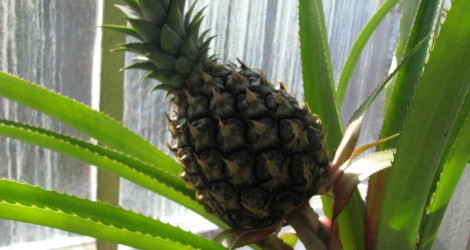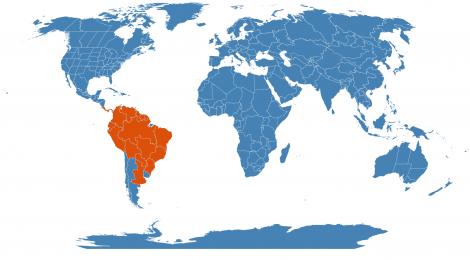Accession Data:
Ananas comosus Merr.
- Common Name: Pineapple
- Family: Bromeliaceae Juss.
- Description: Perennial herb native to Brazil. The only common food plant in the Bromeliaceae. Cultivated commercially in the tropics and parts of the subtropics of the Old and New Worlds, with Hawaii producing one-third of the worlds crop. First domesticated by the Guarani Indians in what is now northern Paraguay before the arrival of the Spanish. Unlike other edible plants from the new world, the pineapple was quickly accepted by the Europeans.
The pineapple itself is a multiple fruit formed by the partial fusion of numerous fleshy segments from several separate flowers in which the hardened sepals from a continuous rind over the outside. The fruit is normally seedless due to self incompatibility and the use of Triploid cultivars.
The major portion of the pineapple crop is canned. They are also eaten raw, dried, in confectionaries and a juice is extracted. Cores have been made into candles. The juice is the source of denatured alcohol and an alcoholic beverage, 'Vin d' Ananas'. Pressed peels and cores are used as food for livestock. Pineapple waste is made into vinegar. Leaves are a source of a hard fiber called 'Pina Fibre'. The fruit which must be ripened on the plant contains about 15 percent sugar plus fruit acids, vitamins and minerals. There are many different varieties cultivated.
[Thai: sapparot (laai)]
- Uses: Medicinal: Contains Bromelain, which acts as an anti-inflammatory and proteolytic.
- IMPORTANT NOTE: Plant Uses are for informational purposes only. EEB Greenhouses assume no responsibility for adverse effects from the use of any plants referred to on this site. Always seek advice from a professional before using any plant medicinally.
- USDA Zone: 11
Accession Data:
- Accession # 198500386
- Source: Unknown
- Accession Date: 12-31-1985
- Bench: 1315 - NEOA: East Bench SS
- Currently: active - healthy
- Qty: 2 confirmed on 10-08-2024
Classification:
- Division: Magnoliophyta
- Class: Liliopsida
- SubClass: commelinids
- Order: Poales
- SubOrder:
- Family: Bromeliaceae
- SubFamily: Bromelioideae
- Tribe:
- SubTribe:
Flowering Data:
This accession has been observed in bloom on:| Year | Jan | Feb | Mar | Apr | May | Jun | Jul | Aug | Sep | Oct | Nov | Dec | ||||||||||||||||||||||||||||||||||||||||
|---|---|---|---|---|---|---|---|---|---|---|---|---|---|---|---|---|---|---|---|---|---|---|---|---|---|---|---|---|---|---|---|---|---|---|---|---|---|---|---|---|---|---|---|---|---|---|---|---|---|---|---|---|
| 2025 | ||||||||||||||||||||||||||||||||||||||||||||||||||||
| 2024 | ||||||||||||||||||||||||||||||||||||||||||||||||||||
| 2023 | ||||||||||||||||||||||||||||||||||||||||||||||||||||
| 2022 | ||||||||||||||||||||||||||||||||||||||||||||||||||||
| 2021 | ||||||||||||||||||||||||||||||||||||||||||||||||||||
| 2020 | ||||||||||||||||||||||||||||||||||||||||||||||||||||
| 2019 | ||||||||||||||||||||||||||||||||||||||||||||||||||||
| 2018 | ||||||||||||||||||||||||||||||||||||||||||||||||||||
| 2017 | ||||||||||||||||||||||||||||||||||||||||||||||||||||
| 2016 | ||||||||||||||||||||||||||||||||||||||||||||||||||||
| 2015 | ||||||||||||||||||||||||||||||||||||||||||||||||||||
| 2014 | ||||||||||||||||||||||||||||||||||||||||||||||||||||
| 2013 | ||||||||||||||||||||||||||||||||||||||||||||||||||||
| 2012 | ||||||||||||||||||||||||||||||||||||||||||||||||||||
| 2011 | ||||||||||||||||||||||||||||||||||||||||||||||||||||
| 2010 | ||||||||||||||||||||||||||||||||||||||||||||||||||||
| 2009 | ||||||||||||||||||||||||||||||||||||||||||||||||||||
| 2008 | ||||||||||||||||||||||||||||||||||||||||||||||||||||
References (internal):
- EEB 3271 - Systematic Botany
- EEB 3203 - Developmental Plant Morphology
- Edible Plants
- Plants with Edible Fruits
- Medicinal Plants
- Medicinal Plants - Traditional African Medicine
- EEB Greenhouse Holdings native to: Costa Rica / Panama / French Guiana / Guyana / Suriname / Venezuela / Bolivia / Colombia / Ecuador / Peru / Brazil West-Central / Brazil Northeast / Brazil Southeast / Brazil North / Brazil South / Argentina Northeast / Paraguay
References (external):
- EEB greenhouse tour guide prepared by Richard Piacentini, no date given, original source material from Uphof, 1968 & Schery, 1972
- The Plant List (2013). Version 1.1. Last accessed on Friday, July 21, 2017.
- WCSP (2016). World Checklist of Selected Plant Families. Facilitated by the Royal Botanic Gardens, Kew. Last accessed on Friday, July 21, 2017.
- Ananas comosus at Global Biodiversity Information Facility. Last accessed on Friday, July 21, 2017.
data regenerated on Tue, 20 May 2025 14:21:01 -0400 [bcm v4.0]
Images:

Additional images for this accession:
Click on thumbnails to enlargeCurrent Accessions in the Bromeliaceae
Subfamily Brochinioideae
Subfamily Bromelioideae
- Acanthostachys strobilacea


- Aechmea allenii

- Aechmea brevicollis


- Aechmea chantinii


- Aechmea fasciata


- Aechmea recurvata


- Ananas bracteatus `Striatus'

- Ananas comosus


- Billbergia distachia

- Billbergia lietzei


- Billbergia magnifica

- Billbergia nutans


- Billbergia porteana


- Billbergia pyramidalis



- Cryptanthus bivittatus


- Cryptanthus cf. seidelianus

- Neoregelia ampullacea

- Neoregelia carolinae


- Neoregelia cruenta

- Neoregelia lilliputiana

- Neoregelia spectabilis


- Neoregelia tigrina
- Neoregelia zonata

- Nidularium innocentii

- Nidularium microps

- Ochagavia carnea

- Portea petropolitana


Subfamily Hechtioideae
Subfamily Pitcairnioideae
- Deuterocohnia brevifolia


- Dyckia brevifolia


- Dyckia fosteriana

- Fosterella penduliflora

- Pitcairnia atrorubens


- Pitcairnia heterophylla


- Pitcairnia xanthocalyx

Subfamily Puyoideae
Subfamily Tillandsioideae
- Catopsis sp.

- Tillandsia albida

- Tillandsia albida

- Tillandsia baileyi

- Tillandsia brachycaulos

- Tillandsia bulbosa


- Tillandsia caerulea

- Tillandsia graomogolensis

- Tillandsia heteromorpha

- Tillandsia intermedia

- Tillandsia ionantha


- Tillandsia jonesii

- Tillandsia purpurea


- Tillandsia recurvata

- Tillandsia seleriana

- Tillandsia simulata

- Tillandsia simulata

- Tillandsia stellifera

- Tillandsia tectorum X paleacea
- Tillandsia tenuifolia Emerald Forest

- Tillandsia unidentified

- Tillandsia usneoides


- Tillandsia usneoides W/C


- Tillandsia usneoides W/C


- Tillandsia usneoides W/C


- Tillandsia xerographica


- Vriesea correia-araujoi

- Vriesea flammea

- Vriesea fosteriana

- Vriesea splendens

 = indicates flowering in past 14 days
= indicates flowering in past 14 days
 = images available for this accession
= images available for this accession
 = map available for this accession
= map available for this accession
 = accession added within past 90 days
= accession added within past 90 days

